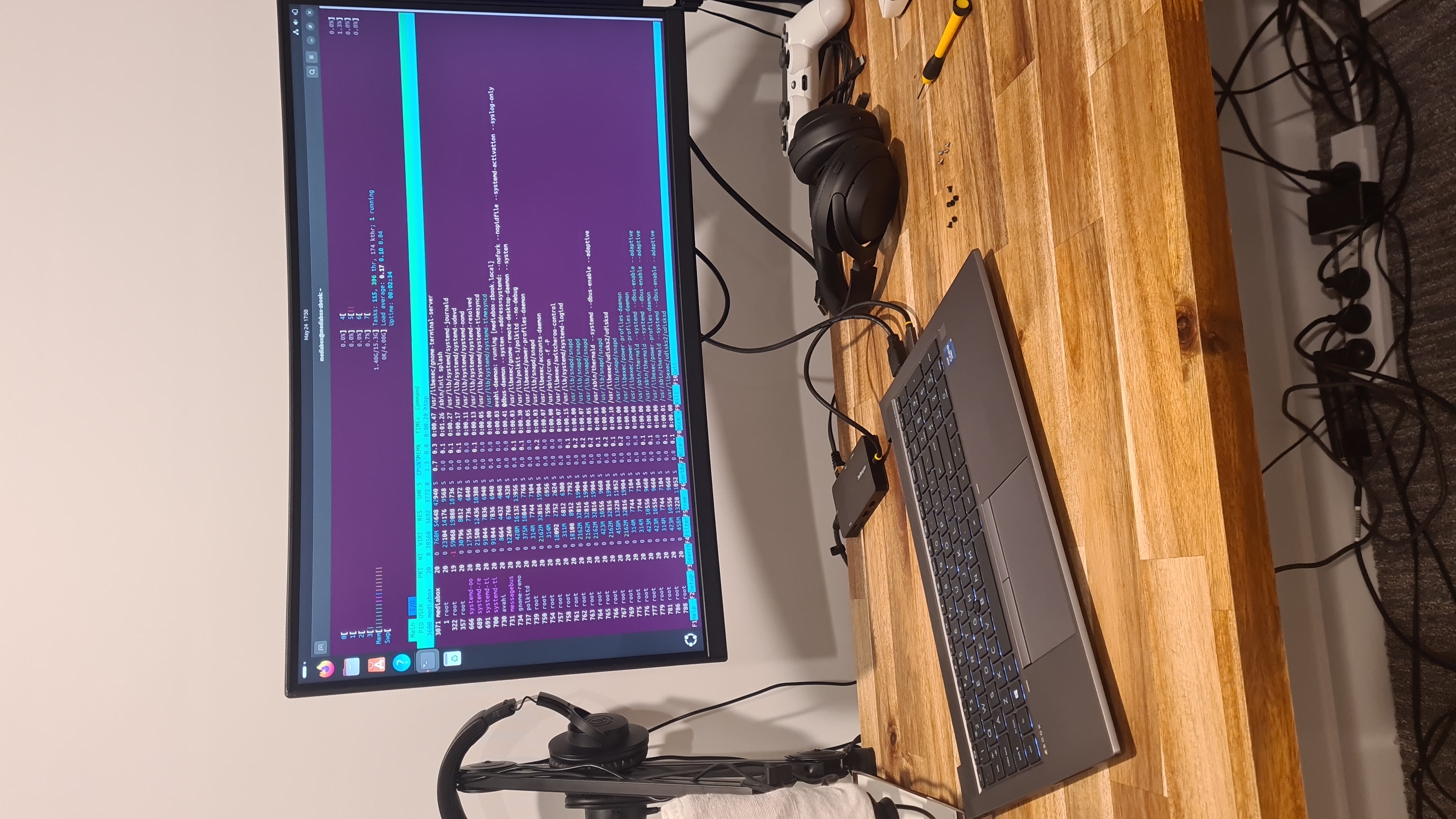Overview
Managed to get an old Zbook working after it refused to boot. It had a damaged screen, so I yanked it out and rewired the wifi card.

Turns out it just needed some new RAM sticks and now purrs away happily. Specs:

Home server setup
I fell in love with the Glance dashboard. This is a great way to keep track of all of your services and even external websites.

An abridged version of the .yml I use and my file structure is:
$ tree
.
├── assets
│ ├── file-browser-logo.png
│ ├── immich-logo.png
│ ├── jellyfin-logo.png
│ ├── octoprint-logo.png
│ ├── rocket.svg
│ └── user.css
├── config
│ ├── glance.yml
│ └── minimal.yml
└── docker-compose.yml
config/glance.yml:
server:
assets-path: /app/assets
theme:
# Note: assets are cached by the browser, changes to the CSS file
# will not be reflected until the browser cache is cleared (Ctrl+F5)
custom-css-file: /assets/user.css
background-color: 50 1 6
primary-color: 24 97 58
negative-color: 209 88 54
pages:
# It's not necessary to create a new file for each page and include it, you can simply
# put its contents here, though multiple pages are easier to manage when separated
- $include: minimal.yml
config/minimal.tml
- name: Minimal
# Optionally, if you only have a single page you can hide the desktop navigation for a cleaner look
# hide-desktop-navigation: true
columns:
- size: small
widgets:
- type: calendar
first-day-of-week: monday
- type: monitor
cache: 1m
title: Mediabox
sites:
- title: Jellyfin
url: http://your-ip-goes-here
icon: /assets/jellyfin-logo.png
allow-insecure: true
- title: File Browser
url: http://your-ip-goes-here
icon: /assets/file-browser-logo.png
allow-insecure: true
- title: Immich
url: http://your-ip-goes-here
icon: /assets/immich-logo.png
allow-insecure: true
- title: OctoPrint
url: http://your-ip-goes-here
icon: /assets/octoprint-logo.png
allow-insecure: true
- title: My website
url: https://shaunlowis.com
icon: /assets/rocket.svg
- size: full
widgets:
- type: search
search-engine: duckduckgo
new-tab: true
bangs:
- title: YouTube
shortcut: "!yt"
url: https://www.youtube.com/results?search_query={QUERY}
- type: videos
channels:
- UCPkaARl89RCckNE_D7tj-aA # Gorgc
- UC5Ghe5TBQGYIOANuiNW4hDQ # Gary's Economics
- UCxzC4EngIsMrPmbm6Nxvb-A # Scott Manley
- UCaYLBJfw6d8XqmNlL204lNg # ESL Dota 2
- type: markets
markets:
- symbol: BTC-USD
name: Bitcoin
- symbol: AMD
name: AMD
- symbol: MSFT
name: Microsoft
- symbol: NVDA
name: NVIDIA
- symbol: NZG
name: Smart S&P/NZX 50
- symbol: TSM
name: TSMC
- size: small
widgets:
- type: weather
location: Auckland, New Zealand
units: metric # alternatively "imperial"
hour-format: 12h # alternatively "24h"
# Optionally hide the location from being displayed in the widget
# hide-location: true
- type: docker-containers
hide-by-default: false
Then I also added this page as my default page when I open my Brave browser:
Settings -> Get started -> On startup -> Open a specific page or set of pages.
Networking
DNS setup
For some reason, my local network seems to use some seriously cooked DNS configs. Had to manually change to Google DNS:
sudo vim /etc/systemd/resolved.conf
# Change:
[Resolve]
DNS=8.8.8.8 8.8.4.4
#FallbackDNS=
#Domains=
#LLMNR=yes
#MulticastDNS=yes
#DNSSEC=no
#Cache=yes
#DNSStubListener=yes
sudo systemctl restart systemd-resolved
# Then check fix:
ping google.com
Static IP
Quite useful for not having to juggle IP's after reboots. My network is managed, so I can only wiggle around a specific range. Check the name of your connection with:
nmcli device show wlp0s20f3 | grep 'GENERAL.CONNECTION'
# Assuming output looks like:
GENERAL.CONNECTION: BIGCHEESE
# Then modify to a suitable static IP with:
nmcli connection modify "BIGCHEESE" \
ipv4.addresses 192.111.11.200/24 \
ipv4.gateway 192.111.11.1 \
ipv4.dns "1.1.1.1 8.8.8.8" \
ipv4.method manual
sudo nmcli connection down "BIGCHEESE" && sudo nmcli connection up "BIGCHEESE"
Then after a few seconds, you should see a nice new static IP with:
ip -c -h address
Samba server
I found that my GUI is sometimes useful, but having a mounted mediashare is nicer for windows --> linux file sharing. This guide is the best one I found online.
Example samba config:
[mediashare]
comment = Mediabox File Share
path = /home/mediabox/media_folder
browsable = yes
read only = no
valid users = mediabox
create mask = 0664
directory mask = 0775
For me this is an external drive connected over USB, so I also have an fstab entry:
# 2TB hDD
UUID="98e6a5d9-5787-4d82-843d-f25cb4ea95e8" /home/mediabox/media_folder ext4 defaults,nofail,x-systemd.automount 0 2
This required some permissions changes, to the above mediabox user:
sudo chown -R mediabox:mediabox /home/mediabox/media_folder
You can check your smb config with:
testparm -s
Then, make sure to mount it on a windows machine by:
- Open File Explorer
- Right-click on This PC → Map network drive
- Choose a drive letter (e.g., Z:)
- In the folder box, enter your Samba share path:
- Copy
- Edit
- \IP-ADDRESS\sharename
- Check the box for "Connect using different credentials"
- Hit Finish
Don't mount it by putting the fileshare address in the network bar, it won't work. At least not for me.
File server
I like using docker and the File Browser project seems nice.
cd /some/folder/you/want/to/use
touch filebrowser.db
mkdir srv # this is the base dir of the web gui
vim filebrowser.json
# Add below json
{ "port": 80, "baseURL": "", "address": "", "log": "stdout", "database": "/database.db", "root": "/srv" }
vim docker-compose.yml
services:
filebrowser:
image: filebrowser/filebrowser
container_name: filebrowser
user: 1000:1000
ports:
- "8080:80"
volumes:
- ./srv:/srv # files will be stored here
- ./filebrowser.db:/database.db # users info/settings will be stored here
- ./filebrowser.json:/.filebrowser.json # config file
restart: always
And then you can access this at port 8080 on your host machine. Your hostname should work, or base IP, so either of:
whoami
ip -c -h address